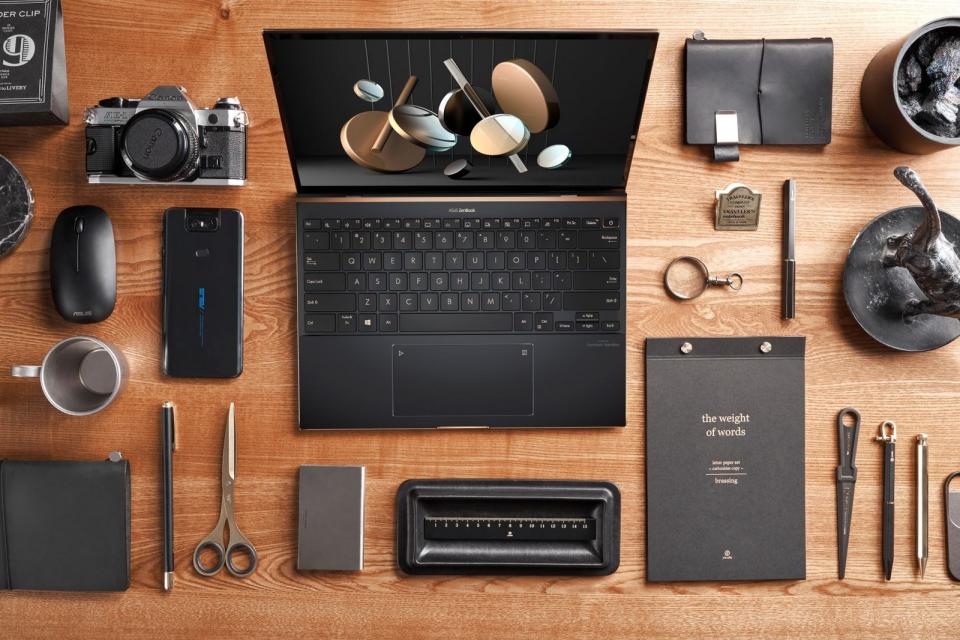ASUS' latest ZenBooks feature OLED and 'Intel Evo' designs
You can expect 11th-gen Intel CPUs across the board.
Like clockwork, ASUS and other PC makers have a slew of new machines to show off alongside Intel’s latest CPU announcement. This time around, though, there’s a lot more going on than just a simple processor bump. Intel is rebadging its “Project Athena” initiative for next-generation laptop designs as “Intel Evo,” and ASUS is eager to show off its own contributions. Alongside the usual ZenBook upgrades, the company is unveiling several thin and light notebooks with gorgeous OLED screens and some of its slickest designs yet.
Take the ZenBook Flip S, an 13.9 millimeter thin beauty with a convertible 4K OLED screen. It weighs just 2.6 pounds, and is ASUS’s first Evo-certified notebook. While it doesn’t look that much different than ASUS’s previous ZenBooks, there’s a lot going on under the hood. That 4K OLED, for example, features HDR 500 certification for better bright and black levels while streaming video. And it supports 4,096 levels of pressure with the new ASUS Pen. In many ways, it’s the rotating convertible I’ve always wanted the Surface Laptop to be.
The ZenBook Flip S can be configured with up to Intel’s 11th generation Core i7 CPUs with Xe graphics, 16GB of RAM and a 1TB PCIe SSD. And despite being so thin, it offers a surprising amount of connectivity: two Thunderbolt 4 USB-C ports; a USB 3.2 Type A connection; and an HDMI port.

The ZenBook Flip 13 (above), meanwhile, is just as thin as the Flip S and a tad heavier. It’s also a convertible, meaning it can be rotated into laptop, tent and tablet modes, and features a 1080p OLED screen. (Trust me, you’d be hard pressed to really see the resolution difference while watching video on a laptop.) ASUS doesn’t mention any HDR support, but the addition of OLED alone gives it a leg up over most LCD screens.
Given that the Flip 13 also features stylus support, it’s likely going to be a cheaper alternative for people who like the idea of the Flip S for slightly less. (We don’t have pricing details on any of these new machines, unfortunately.)
And what if you don’t care about twisting your screen around? That’s where the new ZenBook S (below) comes in: It features a 13.9-inch 3.3K screen with a tall 3x2 aspect ratio. That makes it a pretty direct competitor to the Surface Laptop 3. A towering screen like that is ideal for productivity, since it can fit in much more content than standard 16x9 widescreen displays.

At 15.7mm thin and 3 pounds, the ZenBook S is a bit chunkier than the new convertibles, but you can also take advantage of some faster hardware, like an M.4 SSD. Alongside Thunderbolt 4 USB-C ports and USB 3.2 Type-A ports, it also includes full-sized HDMI and a microSD card reader. (We’d still prefer a full-sized SD card reader, though.)
While the ZenBook Flip S is the only Intel Evo approved machine so far, I would’t be surprised if the other S models get that badge later this year. Consider them a preview of where all of ASUS’s notebook designs are going eventually.
To that end, ASUS is referring to its existing models as its “ZenBook Classic” line. These include the new ZenBook 13 and 14 (UX425EA), which are, as usual, thinner and lighter than the previous models. They’re both 13.9 millimeters thick, and the ZenBook 13 starts at just 2.35 pounds. These will likely be ASUS’s premium machines for people who don’t want to splurge extra for the “S” design. They also support up to 32GB of RAM, making them better options for serious work.
ASUS being ASUS, though, its new lineup is also a bit confusing. There’s another ZenBook 14 model (UX435) that comes with NVIDIA’s GeForce MX450 GPU. That’ll make it suitable for light gaming, like a bit of Overwatch, but it wouldn’t be a replacement for a dedicated GPU. This better equipped ZenBook 14 also includes a new version of ASUS’s ScreenPad, a secondary display tucked underneath its trackpad.
The company is also bringing 11th generation Intel processors, and a slew of upgrades, to its entire VivoBook line. We typically focus more on the premium ZenBooks, but it’s still nice to see that ASUS hasn’t forgotten about its cheaper VivoBooks. These are machines where the company gets a bit more colorful too, so they may be better options for students and younger users who may not need the sleek design of a ZenBook.
Finally, ASUS unveiled two new machines that may appeal to professional and corporate users. The new ZenBook Pro 15 features a 4K OLED touchscreen, the revamped ScreenPad and can be configured with up to NVIDIA GeForce GTX 1650Ti graphics. You’re limited to 10th generation Intel CPUs, but at least they’re the faster H-series variants. The ExpertBook B9, meanwhile, is a sleek new enterprise entry that supports RAID 0 and RAID 1 across two SSDs.
You’ll be able to snag the ZenBook “S” machines in October, alongside the ZenBook Pro 15 and many of the VivoBooks. The ZenBook 14 is coming in November, while the machines will come later in the year.

 Yahoo Lifestyle
Yahoo Lifestyle 
